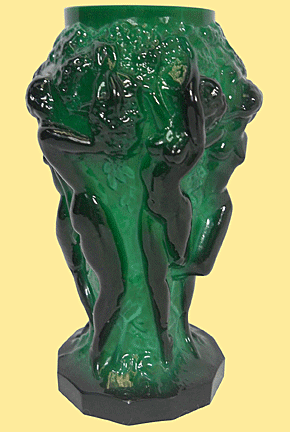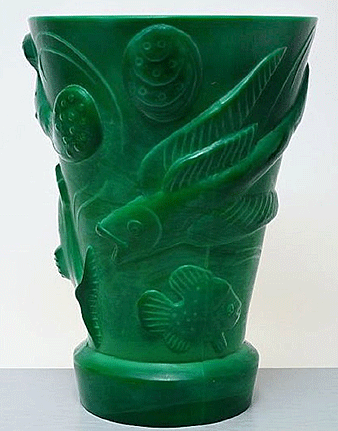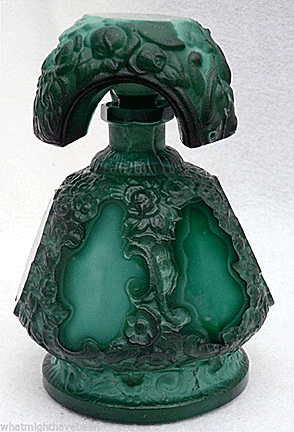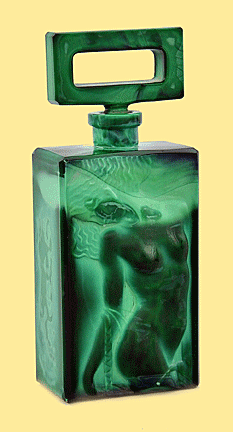The Shimmer of Ingrid Glass
by Bob Brooke
________________________________________________________
QUESTION:
 I
was browsing at a flea market recently and discovered a beautiful green
glass vase that looked like marble. The dealer didn’t know anything
about it and said she had picked it up at a garage sale. I’ve never seen
anything like it. It had veins like marble and shimmered in the
sunlight. I had to have it. And now that I do, I’d love to know more
about it. Can you tell my anything about this marble glass? How old is
it and where was it made? I
was browsing at a flea market recently and discovered a beautiful green
glass vase that looked like marble. The dealer didn’t know anything
about it and said she had picked it up at a garage sale. I’ve never seen
anything like it. It had veins like marble and shimmered in the
sunlight. I had to have it. And now that I do, I’d love to know more
about it. Can you tell my anything about this marble glass? How old is
it and where was it made?
Thanks,
Charlotte
__________________________________________________________
ANSWER:
 It’s
seems that you’ve purchased what’s commonly known as “malachite” glass.
The mineral malachite is a green copper carbonate stone which occurs
naturally and has concentric layers. It’s especially prevalent in Russia
and was a favorite of the czars. The inventors of malachite glass
intended it to simulate marble. Many 19th-century glassworks used the
term and each created their own variation on this theme. Those items
made of this type of glass from the former Czechoslovakia go by another
name—Ingrid. It’s
seems that you’ve purchased what’s commonly known as “malachite” glass.
The mineral malachite is a green copper carbonate stone which occurs
naturally and has concentric layers. It’s especially prevalent in Russia
and was a favorite of the czars. The inventors of malachite glass
intended it to simulate marble. Many 19th-century glassworks used the
term and each created their own variation on this theme. Those items
made of this type of glass from the former Czechoslovakia go by another
name—Ingrid.
Ingrid is the name of a series of artistic pressed glass items created
by Henry Schlevogt and named for his daughter. Henry was the son of Curt
Schlevogt, who around 1900 founded a firm in Jablonec, Bohemia, to
produce glass beads and buttons. His wife, Charlotte, was the daughter
of Heinrich Hoffmann, the owner of a glass company that made and
exported sculptures, beads and hollowware.
But Henry knew that the "beads and buttons" business was a difficult one
because of the tough competition from so many companies in the area and
from other countries. He wrote to his daughter, Ingrid, that knowledge
he gained in other countries had led him to create items that were so
beautiful that the price wouldn’t matter.
 At
the Spring Trade Fair in Leipzig in 1934, Schlevogt introduced a line of
ornamental crystal sculptures, and the same year presented the line at
the Chicago World's Fair. The Ingrid brand was born. And while it was
Curt Schlevogt who designed most of the molds used to make the glass, it
was Henry who knew how to promote their new line of glass. Ingrid was so
well received at the Fair that the firm began producing it on a large
scale. At
the Spring Trade Fair in Leipzig in 1934, Schlevogt introduced a line of
ornamental crystal sculptures, and the same year presented the line at
the Chicago World's Fair. The Ingrid brand was born. And while it was
Curt Schlevogt who designed most of the molds used to make the glass, it
was Henry who knew how to promote their new line of glass. Ingrid was so
well received at the Fair that the firm began producing it on a large
scale.
Schlevogt reached out to designers working with the Wiener Werkstatte,
including Franz Hagenauer, Ena Rottenberg, and Vally Wieselthier, and
also to designers who worked for other major glass firms, such as Bruno
Mauder, Eleon von Rommel, and Alexander Pfohl. The result was a complete
line of ornamental sculptures, perfumes with figural daubers and/or
impressed stoppers, liquor sets, toilet sets, devotional items,
figurines, table ware, and vases.
 Henry
Schlevogt utilized the technology at the Riedel glassworks in Polubny,
Czechoslovakia, to make this artistic, marbled, pressed glass. But just
because his firm pressed the glass into molds, didn’t mean that it was
of inferior quality. The glass, itself, was pure. Workers ground out the
mold marks and frosted or polished the surfaces. They even engraved some
of the details. Henry
Schlevogt utilized the technology at the Riedel glassworks in Polubny,
Czechoslovakia, to make this artistic, marbled, pressed glass. But just
because his firm pressed the glass into molds, didn’t mean that it was
of inferior quality. The glass, itself, was pure. Workers ground out the
mold marks and frosted or polished the surfaces. They even engraved some
of the details.
The most common items are those made of jade green and lapis blue
marbled glass. The company’s 1939 catalog shows more than 200 crystal
and another 80 jade/lapis items.
Schlevogt's crystal perfumes aren’t as easily identified. Some appear in
the firm's catalogs, but the vast majority have been included in the
broad category of Czechoslovakian glass in most listings. The designs
for perfumes included bottles in various Art Deco shapes, and stoppers
with relief-pressed nudes, couples, flowers, and butterflies.
 By
1936, Schlevogt had business representatives in several European cities.
When the Czechoslovak pavilion won a Grand Prize at the 1937 Paris
World's Fair, Schlevogt's ornamental sculptures by Ena Rottenberg and
Josef Bernhard were part of the reason. By 1940, the Schlevogt firm
owned more than 1,300 glass molds, coin molds, and hand presses. It had
its own cutting, sandblasting, and acid-etching workshops, but continued
to have the glass shapes pressed at the Riedel firm. By
1936, Schlevogt had business representatives in several European cities.
When the Czechoslovak pavilion won a Grand Prize at the 1937 Paris
World's Fair, Schlevogt's ornamental sculptures by Ena Rottenberg and
Josef Bernhard were part of the reason. By 1940, the Schlevogt firm
owned more than 1,300 glass molds, coin molds, and hand presses. It had
its own cutting, sandblasting, and acid-etching workshops, but continued
to have the glass shapes pressed at the Riedel firm.
The Czechoslovak government nationalized the glass industry after World
War II and sentenced Henry Schlevogt to prison in Siberia. After his
release in 1948, the Communist government in Czechoslovakia t banished
him. He first went to Austria, then accepted an offer to manage the
glassworks in Romilly-sur-Andelle, France. He sold this firm in 1972 and
died in Paris in 1984.
Collectors need to be cautious, however, since the Ingrid molds have
been used continuously. In addition, unauthorized versions of Ingrid
items have been made from reverse-engineered molds.
<
Back to Readers Ask Archives
Next Article > |
